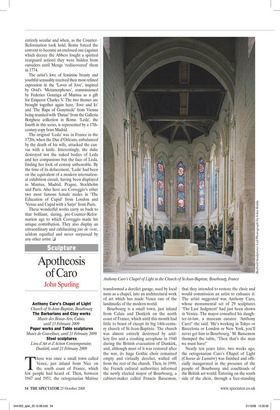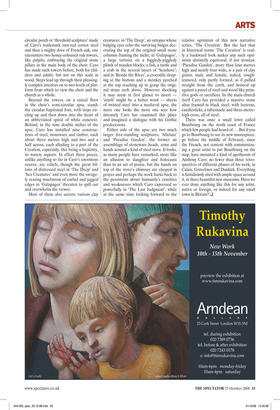Apotheosis of Caro
John Spurling
Anthony Caro’s Chapel of Light Church of St-Jean-Baptiste, Bourbourg The Barbarians and Clay works Musée des Beaux-Arts, Calais, until 23 February 2009 Paper works and Table sculptures Musée de Gravelines, until 21 February 2009 steel sculptures Lieu d’Art et d’Action Contemporaine, Dunkirk, until 21 February 2009
There was once a small town called Vence, just inland from Nice on the south coast of France, which few people had heard of. Then, between 1947 and 1951, the octogenarian Matisse transformed a derelict garage, used by local nuns as a chapel, into an architectural work of art which has made Vence one of the landmarks of the modern world.
Bourbourg is a small town, just inland from Calais and Dunkirk on the north coast of France, which until this month had little to boast of except its big 14th-century church of St-Jean-Baptiste. The church was almost entirely destroyed by artillery fire and a crashing aeroplane in 1940 during the British evacuation of Dunkirk, and, although most of it was restored after the war, its huge Gothic choir remained empty and virtually derelict, walled off from the rest of the church. Then, in 1999, the French cultural authorities informed the newly elected mayor of Bourbourg, a cabinet-maker called Francis Bassemon, that they intended to restore the choir and would commission an artist to enhance it. The artist suggested was Anthony Caro, whose monumental set of 29 sculptures ‘The Last Judgment’ had just been shown in Venice. The mayor consulted his daughter-in-law, a museum curator. ‘Anthony Caro!’ she said. ‘He’s working in Tokyo or Barcelona or London or New York, you’ll never get him to Bourbourg.’ M. Bassemon thumped the table, ‘Then that’s the man we must have!’ Nearly ten years later, two weeks ago, the octogenarian Caro’s Chapel of Light (Choeur de Lumière) was finished and officially inaugurated in the presence of the people of Bourbourg and coachloads of the British art-world. Entering on the south side of the choir, through a free-standing circular porch or ‘threshold sculpture’ made of Caro’s trademark rust-red corten steel and then a mighty door of French oak, one encounters two honey-coloured oak towers, like pulpits, embracing the original stone pillars in the main body of the choir. Caro has made such towers before, both for children and adults, but not on this scale in wood. Steps lead up through their pleasingly complex interiors on to two levels of platform from which to view the choir and the church as a whole.
Beyond the towers, on a raised floor in the choir’s semi-circular apse, stands the circular baptismal font, with steps circling up and then down into the heart of an abbreviated spiral of white concrete. Behind, in the nine double niches of the apse, Caro has installed nine constructions of steel, stoneware and timber, each about three metres high and two and a half across, each alluding to a part of the Creation, especially, this being a baptistry, its watery aspects. In effect these pieces, unlike anything so far in Caro’s enormous oeuvre, are reliefs, though the great billows of distressed steel in ‘The Deep’ and ‘Sea Creatures’ and even more the savagely rearing maelstrom of curled and jagged edges in ‘Galapagos’ threaten to spill out and overwhelm the viewer.
Most of them also secrete various clay creatures: in ‘The Deep’, an octopus whose bulging eyes echo the surviving bulges decorating the top of the original small stone columns framing the niche; in ‘Galapagos’, a large tortoise on a higgledy-piggledy plinth of wooden blocks; a fish, a turtle and a crab in the several layers of ‘Seashore’; and in ‘Beside the River’, a crocodile sleeping at the bottom and a monkey perched at the top reaching up to grasp the original stone arch above. However shocking it may seem at first glance to insert — ‘crush’ might be a better word — sheets of twisted steel into a medieval apse, the more one looks the more one sees how intensely Caro has examined this place and imagined a dialogue with his Gothic predecessors.
Either side of the apse are two much larger free-standing sculptures, ‘Alleluia’ and ‘Paradise Garden’, the former an assemblage of stoneware heads, arms and hands around a kind of steel stove. It looks, as many people have remarked, more like an allusion to slaughter and holocaust than to an act of praise, but the hands on top of the stove’s chimney are clasped in prayer and perhaps the work harks back to the pessimism about humanity’s cruelties and weaknesses which Caro expressed so powerfully in ‘The Last Judgment’, while at the same time looking forward to the relative optimism of this new narrative series, ‘The Creation’. But the fact that in historical terms ‘The Creation’ is really a backward look makes any such optimism distinctly equivocal, if not ironical. ‘Paradise Garden’, more than four metres high and nearly four wide, is a pair of clay giants, male and female, naked, roughtextured, only partly formed, as if pulled straight from the earth, and hoisted up against a panel of steel and wood like primitive gods or sacrifices. In the main church itself Caro has provided a massive stone altar framed in black steel, with lecterns, candlesticks, a tabernacle and three-metrehigh cross, all of steel.
There was once a small town called Bourbourg on the north coast of France which few people had heard of ... But if you go to Bourbourg to see its new masterpiece, go before the middle of February, since the French, not content with commissioning a great artist to put Bourbourg on the map, have mounted a kind of apotheosis of Anthony Caro: no fewer than three retrospectives of different phases of his work, in Calais, Gravelines and Dunkirk. Everything is fastidiously sited with ample space around it, in three beautiful new museums. Have we ever done anything like this for any artist, native or foreign, or indeed for any small town in Britain? ❑



















































































 Previous page
Previous page